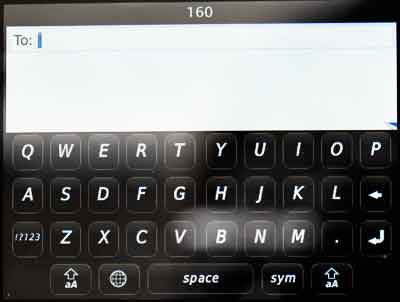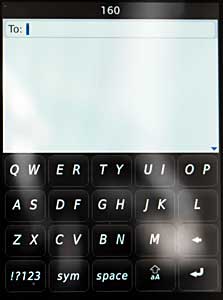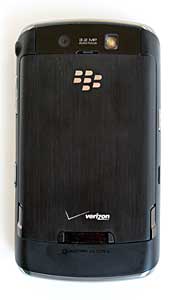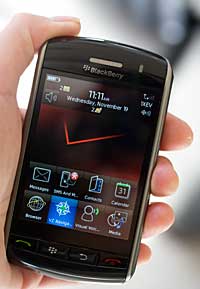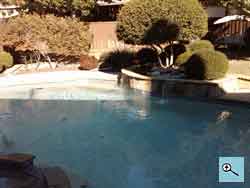
|
||||||||
Performance and OS The Storm runs BlackBerry OS 4.7, which adds touch screen support. The also new BlackBerry Bold in contrast, runs OS 4.6. Speaking of the Bold, a traditional BlackBerry with a full hardware QWERTY keyboard, the specs are quite similar. The Bold actually runs on a somewhat faster Marvell 624MHz CPU while the Storm runs on a 528MHz Qualcomm processor, but both have a gig of internal memory, 128 megs of RAM, GPS, and a high resolution display that's viewable outdoors and stunning indoors. But the Bold adds WiFi to the mix while it loses the touch screen. In favor of the Bold is performance-- it's the usual BlackBerry quick while the Storm lags too often. Firmware updates might tweak performance but we noticed the Storm taking occasional time-outs to think its way through even seemingly simple chores. The waits are sometimes very short and other times a few seconds, reminding us of the bad old days of Windows Mobile.
Design and Ergonomics There's no way around it-- this is one large phone. At 5.5 ounces it carries some serious weight too. If you thought the Bold was big (or at least wide), the Storm isn't smaller. It looks and feels thicker than the Bold though it's actually a tad thinner. The phone is attractive and looks well made, and we like the lightweight metal back plate that covers the battery. The Storm is black with chrome accents along the sides, and is made of plastic (other than the battery cover). The SIM card slot and microSD card slot are under the back door. Thankfully, there's no need to remove the battery to swap a microSD card. Verizon generously provides an 8 gig microSD card in the box, which is their subtle way of saying "yes indeed, it supports SDHC high capacity cards".
The iPhone 3G and BlackBerry Storm. Our beloved BlackBerry menu and back buttons made their way over from the non-touch screen world, and these are flanked by call send and end buttons. That means you can get a few of the basics done without touching that lovely display.
RIM keeps it simple on the sides: the left side has just the voice command button and USB port. The right side houses the 3.5mm stereo headphone jack (headset included), volume control and camera button. The speakerphone, camera lens and flash are on the back, as per normal.
Left side: voice command button and USB port.
Right side: camera button, volume buttons and 3.5mm stereo headset jack. Phone and Data The Storm is a dual band digital CDMA phone that works on Verizon's network in the US. It has 1x and EVDO Rev. A for data. The Storm's SIM card slot is for overseas roaming on a Vodafone SIM as we mentioned. Handy for world travelers, along with Verizon's international data roaming plans. Voice quality is good and volume is loud. The speakerphone is deafeningly loud, yet clear. Dialing on screen is simple and easy, and Nuance's (formerly Voice Signal) voice dialing software is an excellent way to avoid dialing with your digits when driving. Reception is very strong: our office is in a Verizon dead zone, yet the BlackBerry Storm managed to to pull in a decent EVDO rev. A and voice signal when other Verizon phones drop to 1 bar or none. Data is a pleasure on Verizon's EVDO Rev. A network, and our BlackBerry Storm averaged over 1,000 kbps on DSL Reports' mobile speed test. We like the dual function touch screen for browsing-- you can drag the page to scroll to your heart's content with no fear of accidentally tapping a link or banner ad. Likewise double-tapping to zoom does only that. And there are quite a few levels of zoom, making this Berry friendly to old and young eyes alike. The concerted press until click is very effective here. The BlackBerry browser is quite good, and that much better with a touch screen. No more madly driving the trackball around the screen, and the 480 x 360 resolution makes for a page overview that's almost readable on full HTML sites. As always with BlackBerries, some Javascript can befuddle the browser and given the touch screen convention, there's no way to interact with dHTML JavaScript menus (if they're even supported). Full HTML sites' pages do download very quickly over EVDO rev. A and the Storm's page scrolling is responsive, quick and accurate with no re-draw delays. Display and Multimedia The display is marvelous, especially for a touch screen. Though it supports only 65k colors, it looks richer than many other touch screen phone's displays. It's also extremely sharp and even small fonts are clear. The display is perfectly readable outdoors, another relative rarity among touch screen phones (especially Windows Mobile phones). The Storm holds its own against the iPhone on the display quality and outdoor viewability fronts. Like the iPhone, the touch screen does get smudgy quickly, and unlike the iPhone the display surface is plastic, not glass.
Since the BlackBerry Pearl and Curve, BlackBerry smartphones have dropped the suit for trendy multimedia features. We're not complaining. The media player (similar to that on the Bold and other recent BlackBerry phones) is very good at handling music, video and photos. The music player supports MP3 and AAC iTunes format files and can even sync with iTunes (except copy-protected files). Sound quality is good through headphones, both wired and A2DP Bluetooth stereo, and the speaker is very loud and clear. It's loud enough that you could seriously annoy the person next to you on the commuter train or bus. The video player is very capable and handles MPEG4 formats (as always with BlackBerry, it's a little picky about formats). Videos look great on the the large, high resolution display and playback is smooth up to 550 or 600kbps (the Bold handles high bitrate files a bit better, but it has a faster CPU and no touch screen). Given the large display, high capacity microSD card slot and included 8 gig card, the Storm makes a very good portable media player.
GPS The BlackBerry Storm has a built-in GPS that works with the included VZ Navigator. The GPS gets a fix in average time compared to other recent phones, and there's no lag when driving; directions are prompt and the map is spot on with actual location. Navigator costs $9.99/month and it requires a data plan since maps and directions are downloaded over the air. The spoken directions are accurate, loud and clear. In fact the Storm's directions are startlingly loud at anything above the medium volume setting. You can drag maps around with a finger, zoom and save locations to favorites. There are extensive POI listings and traffic information as well.
Conclusion If touch screens tickle your fancy or you've had a bad case of iPhone envy, but can't live without the BlackBerry push email experience and very complete smartphone feature set, the BlackBerry Storm might be for you. Since it's exclusive to Verizon, make sure that their coverage and plans suit your needs, and if that's a go, do check out the Storm. We'd like to see less lag, and hope that this will improve with future firmware updates, but overall the Storm is a pleasing and competent phone-- if you like RIM's new touch screen technology. That's a matter of personal preference: it's not an easy transition if you've become accustomed to non-moving displays. But once you get the hang of it, it works well. Our only complaint is that typing is inherently slower compared to other touch screens when you must press until the display moves and clicks for each keystroke. Pro: Innovative Touch screen. Large and lovely display. Good web browser and the usual superb BlackBerry push email experience. Decent camera, good multimedia performance. Impressive speaker and good GPS. Con: Innovative touch screen. Only available on Verizon (no offense to Verizon but like the iPhone, there's no carrier choice). Slow downs and lagging aren't a part of the usual BlackBerry experience. Large.
Price: $199 with 2 year contract Web sites: www.blackberry.com, www.verizonwireless.com
| ||||||||

